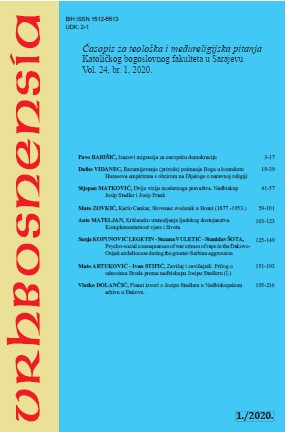DVIJE VIZIJE MODERNOGA PRAVAŠTVA: NADBISKUP JOSIP STADLER I JOSIP FRANK
TWO VISIONS OF RIGHTS: ARCHBISHOP JOSIP STADLER AND JOSIP FRANK
Author(s): Stjepan MatkovićContributor(s): Kevin Sullivan (Translator), Darko Tomašević (Translator)
Subject(s): Christian Theology and Religion, Political history, Government/Political systems, Politics and religion, 19th Century, Pre-WW I & WW I (1900 -1919)
Published by: Katolički bogoslovni fakultet
Keywords: Archbishop Josip Stadler; Josip Frank; Party of Right; Modern Rightism; Habsburg Monarchy;
Summary/Abstract: The author describes the multi-layered relationship between Josip Frank, the leader of the Party of Rights, which was politically active in the Kingdom of Croatia- Slavonia, and the Archbishop of Vrhbosna, Josip Stadler. This relationship was marked by contradictions and different phases. At the beginning of the 20th century, Frank, as the leader of the Party of Rights, was critical of Stadler’s political activity in Bosnia and Herzegovina. Initially, the reason for this view stemmed from Frank’s reliance on the tradition of Starčević’s ideology and certain liberal positions. A second reason lay in Frank’s understanding of rights, which he adjusted to meet the requirements of modern movements in society while he continued to advocate a policy based on the principles of Croatian state rights duly adjusted to accommodate the impact of social modernization. An important element of Frank’s rejection of the actions of the Archbishop of Vrhbosna may be found in his complex attitude towards Muslims from Bosnia and Herzegovina, whom he saw as a key ally in spreading the rights movement in the region. Frank publicly expressed a philo-Muslim position and condemned Stadler’s alleged proselytizing activities. The turning point in relations between Frank and Stadler came after the launch of the New Deal policy; greater cooperation began in the context of the Austro-Hungarian implementation of the annexation of Bosnia and Herzegovina. The Croatian proponents of the New Deal and the proponents of the Croatian-Serbian coalition argued that Bosnia and Herzegovina should be consigned to the Serbian political sphere of action. In this way, there was a division within the political representatives of Bosnian Croats: one part accepted the concept of the New Deal, while the other, including Stadler, rejected such a course and adhered to the principles of Croatian state rights in political life. However, the circle around the heir to the throne, Franz Ferdinand, who supported the “trialist” reform of Austro-Hungary, was gaining in importance. In these circumstances, a stronger connection between Frank and Stadler came to the fore. After the annexation and the introduction of a new constitutional situation in Bosnia and Herzegovina, it was important for Frank to gain a reliable ally, and Stadler also sought support “across the Sava” because without such a connection it was not possible to think about implementing the political goals: acceptance of the rights program from 1894, according to which the Croatian question would be resolved within the framework of the Habsburg Monarchy. In this way, a strong alliance was established, which lasted until the death of Josip Frank (1911), and continued through the cooperation of his successors with the Archbishop of Vrhbosna.
Journal: Vrhbosnensia
- Issue Year: 2020
- Issue No: 1
- Page Range: 41-57
- Page Count: 17
- Language: Croatian

